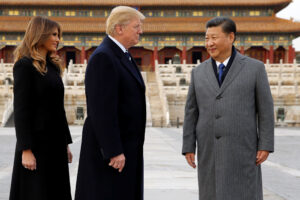The Dangerous Allure of Russian Propaganda in American Media
In a world awash with information, you’d think the truth would be easier to pin down. Yet, for some Americans, the siren call of Russian propaganda has proven intoxicating, luring them to uproot their lives and move to a country that promises safety, opportunity, or ideological alignment—only to find themselves ensnared in a web of lies. The stories of an American couple and a woman of color who fled to Russia, only to face dire consequences, reveal a troubling truth: Russian disinformation doesn’t just thrive in Kremlin-controlled outlets like RT. It seeps into the pages of America’s most trusted newspapers, shaping perceptions and muddying the moral clarity of a war that should be anything but ambiguous.
Take the Huffman family, who proudly declared themselves the first American family to settle in an “American village” in the Moscow region. Their social media posts painted a rosy picture of Russian culture—its food, its traditions, its supposed openness. But the dream soured fast. The husband, who enlisted in the Russian military with visions of honor, found himself thrust onto the front lines of Russia’s war against Ukraine, with no training and little regard for his survival. Within days, the family was begging for help online, their illusions shattered by the brutal reality of Russia’s “meat grinder” tactics. Then there’s the woman who moved to Russia in 2019, fleeing what she called racial discrimination in the U.S. She produced a film with Russia Today, claiming Moscow offered safety and equality for people of color. Yet, shortly after, she was attacked for her race, a cruel irony that underscores the gap between Russia’s promises and its reality.
What unites these stories isn’t just the naivety of their protagonists but the insidious role of propaganda in shaping their choices. You get the sense that these individuals didn’t stumble upon Kremlin talking points by scouring obscure Russian websites. More likely, they encountered them in mainstream Western media, where narratives of moral equivalence and selective outrage often blur the lines between aggressor and victim. A glaring example is a recent feature in The New York Times, one of America’s most influential papers, which ran a sprawling piece on the Russian city of Kursk. Written by a Moscow-based journalist embedded with Russian troops, the article bore all the hallmarks of Kremlin approval—every word vetted, every image curated to paint Ukraine as the villain in a war Russia started.
The Times piece described a devastated Kursk, with images of a forlorn soldier in a damaged church, suggesting Ukrainian forces had left a trail of destruction. What’s troubling is the selective framing. The article conveniently omits that Kursk’s destruction began only after Russian and North Korean troops launched a counteroffensive, bombarding residential areas to reclaim territory. Eyewitness accounts from journalists on the ground paint a starkly different picture: children biking through Kursk’s streets, residents collecting aid, and Ukrainians providing food and medical care to Russian civilians. The primary complaint? Spotty cell phone service due to drone activity—not genocide, as the Times article implied with quotes from Russian residents claiming they were terrified to look Ukrainian soldiers in the eye.
This isn’t just sloppy journalism; it’s a dangerous distortion. The Times article echoes Kremlin narratives by portraying Ukraine’s defensive actions as wanton aggression, while ignoring Russia’s well-documented atrocities—tortured priests in Kherson, destroyed cathedrals in Odesa, and civilian massacres in Bucha and Mariupol. It’s as if the paper’s editors decided that a war sparked by Russia’s unprovoked invasions in 2014 and 2022 deserves a “both sides” treatment, like a family spat rather than a clear-cut case of aggression. This obsession with balance—treating every conflict as a coin with two equal sides—distorts reality and fuels the very propaganda that lured Americans like the Huffmans to Russia in the first place.
To understand why this matters, consider the historical parallels. In the 1930s, The New York Times faced criticism for downplaying the horrors of Stalin’s Holodomor and even framing Hitler’s rise as a positive development. Fast forward to 2025, and the paper seems to be repeating old mistakes, whitewashing Russian actions while amplifying Kremlin-approved voices. The journalist behind the Kursk piece, embedded with Russian troops, operates under constraints that would make any claim of impartiality laughable. In Russia, dissent can mean arrest, torture, or worse—consider the teacher who was jailed and had her children institutionalized for calling Russia the aggressor. Yet the Times quotes Russian civilians uncritically, letting claims of Ukrainian “genocide” stand without context or challenge.
This isn’t to say Ukraine is flawless. War is messy, and no side emerges spotless. But the moral calculus here is clear: Russia invaded Ukraine, not the other way around. Kursk itself was a staging ground for Russia’s 2022 assault on Sumy and Kyiv, with artillery and drones pounding Ukrainian civilians for years before Ukraine’s incursion. To frame Ukraine’s defensive push into Kursk as the root of the region’s suffering is not just misleading—it’s a betrayal of journalistic integrity.
The broader issue is how propaganda thrives in an information ecosystem obsessed with “fairness” over truth. Western media’s insistence on presenting every conflict as a balanced debate creates fertile ground for authoritarian regimes to exploit. Russia’s playbook is simple: flood the airwaves with narratives of victimhood, amplify them through sympathetic or unwitting outlets, and watch as disillusioned Westerners buy into the myth of Russia as a bastion of traditional values or racial harmony. The Huffmans and the woman attacked in Moscow are casualties of this machine, lured by promises that crumble under scrutiny.
What’s particularly galling is how this dynamic undermines the work of journalists who risk their lives for the truth. Independent reporters in Ukraine, like the one who filmed Kursk before the Russian counteroffensive, describe a reality where Ukrainians treated Russian civilians with humanity, not hostility. These accounts, grounded in firsthand observation and free from Kremlin oversight, stand in stark contrast to the Times’ polished propaganda. Yet they struggle to compete with the reach of legacy media, where a single misleading feature can shape public opinion overnight.
So where does this leave us? Frankly, it’s a wake-up call. The next time you open a newspaper or scroll through a news app, pause to ask: Who wrote this? What’s their agenda? Are they free to tell the truth, or are they parroting a script? The stories of Americans duped by Russian propaganda should remind us that disinformation doesn’t always come in a foreign accent—it can hide in the pages of our most trusted institutions. If we’re to navigate this era of information warfare, we need to demand better from our media: less balance for balance’s sake, more courage to call a spade a spade.
In the end, the tragedy of those who moved to Russia isn’t just their personal disillusionment—it’s a warning of what happens when we let propaganda fester unchallenged. The truth is out there, but it’s up to us to seek it, question it, and hold those who distort it to account. Otherwise, we risk becoming complicit in the lies that lead people to trade one form of oppression for another.



